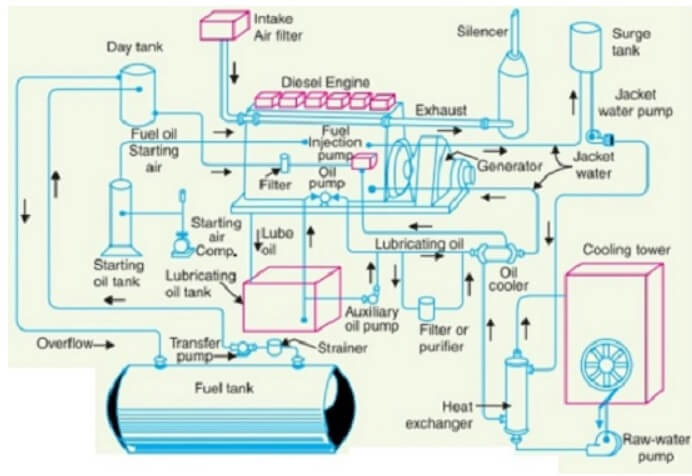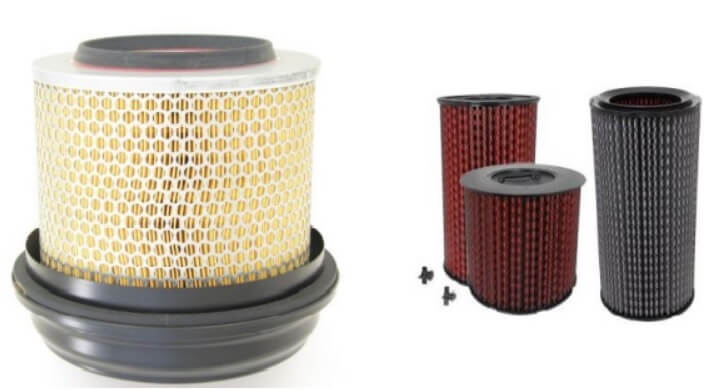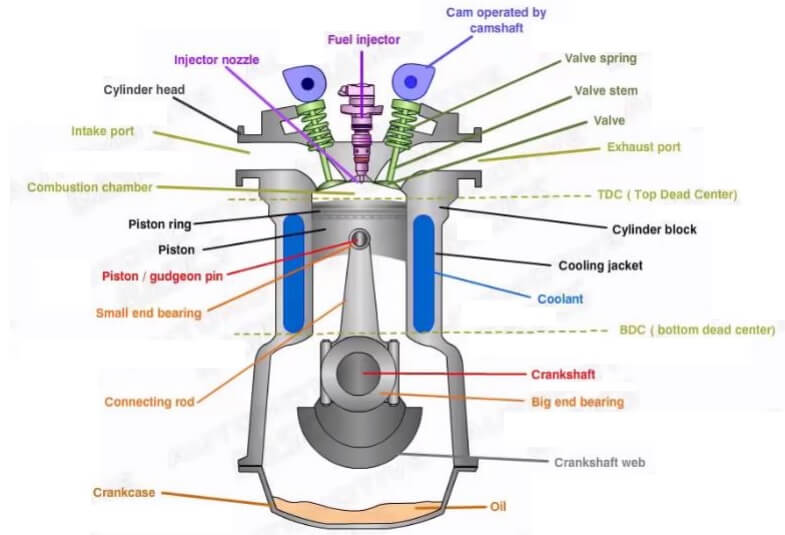A Diesel power plant (also known as Stand by diesel power station) uses a diesel engine as prime mover for the generation of electrical energy.
This power station is generally compact and thus can be located where it is actually required. This kind of power station can be used to produce limited amounts of electrical energy. In most countries these power stations are used as emergency supply stations.
The diesel burns inside the engine and the combustion process causes rotational mechanical energy that turns the engine shaft and drives the alternator. The alternator in turn, converts mechanical energy into electrical energy.
Application of Diesel Power Plant
- Diesel power plant’s is in the range of 2 to 50 MW capacity. Used as central station for small or medium power supplies.
- Used as stand by plants to hydro electric power plants and steam power plants to supply part load when required.
- Used as peak load plants in combinations with thermal or hydro-plants. (5 – 150 MW)
- Mobile power generation
- Emergency plants: Now a days power cut has become a regular feature for industries. The only solution to tide over this difficulty is to install diesel generating sets. They are also used for telecommunication and water supply under emergency conditions.
- The diesel units are used to run the axillaries for starting the large steam plants is called as Starting stations.
Diesel Engine Power Plant
Advantages:
- Higher thermal efficiency than thermal plant
- Wide range of fuels can be used
- Easy fuel handling
- Simple layout, easy to install
- Quick to respond to load variations
- Initial investment is less than other plants
Disadvantages:
- Diesel cost is high
- Does not work satisfactorily under continuous overload conditions
- Noise pollution
- Maintenance cost is high
- Capacity limited to 50 MW
- Life less than steam power plant
Layout of Diesel Engine Power Plant

Essential components of Diesel Power Plant
- Diesel Engine
- Air intake system
- Fuel Supply System
- Engine Starting System
- Lubricating System
- Engine Cooling System
- Exhaust System
- Governing System
Air Intake System
- This system supplies necessary air to the engine for fuel combustion
- It consists of pipes for the supply of fresh air to the engine manifold
- Filters are provided to remove dust particles from air which may act as abrasive in the engine cylinder
- A large power plant requires 4 – 8 m³/kWh of air
- Air intake systems are usually one of two types, wet or dry based on air filtering mechanism
- The air is sucked or bubbled through a housing that holds a bath of oil. The air then flows through a screen type material to ensure any entrained oil is removed from the air

- In a dry filter system, paper, cloth, or a metal screen material is used to catch and trap dirt before it enters the engine
Fuel Supply System
- It consists of storage tank, filters, fuel transfer pump and all day fuel tank
- The fuel oil is supplied at the plant site by rail or road
- The oil is stored in the storage tank. From the storage tank, oil is pumped to smaller all day tank at daily or short intervals
- From this tank, fuel oil is passed through filters to remove suspended impurities
- The clean oil is injected into the engine by fuel injection pump
Engine Starting System
- This is an arrangement to rotate the engine initially, while starting, until firing starts and the unit runs with its own power.
- Small sets are started manually by handles but for larger units, compressed air, electric motors and auxiliary gasoline engines are used for starting
- In case of compressed air, air at high pressure is admitted to a few of the cylinders, making them to act as reciprocating air motors to turn over the engine shaft. The fuel is admitted to the remaining cylinders which makes the engine to start under its own power
Cooling System
- The heat released by the burning of fuel in the engine cylinder is partially converted into work
- The remainder part of the heat passes through the cylinder wall, piston, rings etc. and may cause damage to system
- In order to keep the temperature of the engine parts within the safe operating limits, cooling is provided
- The cooling system consists of a water source, pump, hot well or heat exchanger and cooling towers
- The pump circulates water through cylinder and head jacket
- The water takes away heat form the engine and it becomes hot
- The hot water is cooled by cooling towers and re circulated for cooling
Lubricating System
- The system minimises the wear of rubbing surfaces of the engine. It comprises of lubricating oil tank, pump, filter and oil cooler
- The lubrication oil is drawn from the lubricating oil tank by the pump and is passed through filter to remove impurities
- The clean lubrication oil is delivered to the points which require lubrication
- The oil coolers incorporated in the system keep the temperature of the oil low
- Main parts to be lubricated are crank shaft, wrist pin bearings, bearings and all other moving parts.
- The lubrication of piston and cylinder is different as special lubricant is required for this purpose as the lubricant to operate under high pressure and temperature conditions.
- Another important problem of lubricating system is to remove the impurities like, carbon, water and metal scrap carried by oil during operation. For this, filters, centrifuges or chemical cleaning plants are used.
Exhaust System
- This system leads the engine exhaust gas outside the building and discharges it into atmosphere
- A silencer is usually incorporated in the system to reduce the noise level
- The pressure loss in the system should be reduced to minimum
- The vibration of the system must be isolated from the plant by use of flexible exhaust pipe.
- The exhaust system of a diesel engine performs three functions
- First, the exhaust system routes the spent combustion gasses away from the engine, where they are diluted by the atmosphere. This keeps the area around the engine habitable
- Second, the exhaust system confines and routes the gases to the turbocharger, if used
- Third, the exhaust system allows mufflers to be used to reduce the engine noise
Super charging of Diesel engines
- The power output of the engine increases with an increase in amount of air supplied to the cylinder, which allows to burn more quantity of fuel.
- Supercharging is a term used to process which help to increase the suction pressure of the engine above atm. Pressure and equipment used for this purpose is called super charger.
- A supercharger is an air compressor that increases the pressure or density of air supplied to an internal combustion engine.
- This gives each intake cycle of the engine more oxygen, letting it burn more fuel and do more work, thus increasing power.
- Power for the supercharger can be provided mechanically by means of a belt, gear, shaft, or chain connected to the engine’s crankshaft.
- When power is provided by a turbine powered by exhaust gas, a supercharger is known as a turbo supercharger typically referred to simply as a turbocharger or just turbo.
| Read More Topics |
| Types of DC Motors |
| Hall effect sensor work |
| Electrical machine design |
| Hydraulic and pneumatic system |






